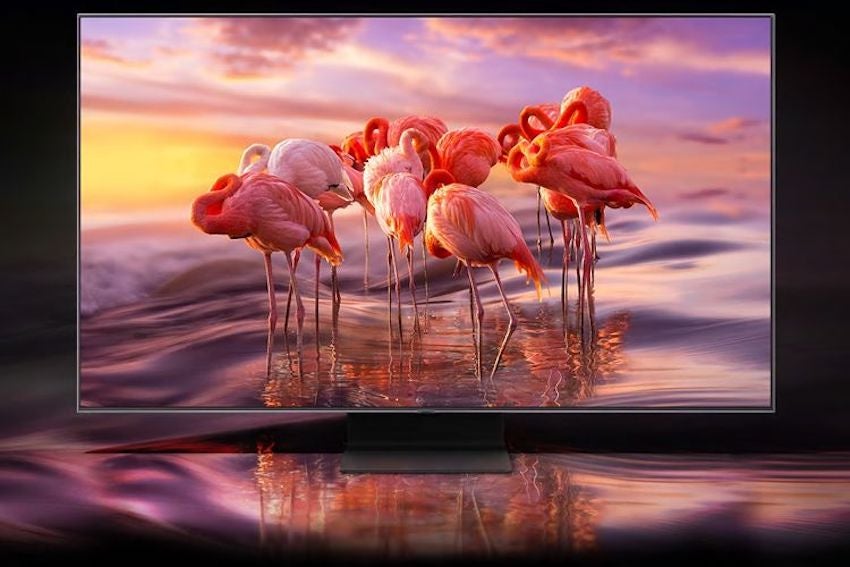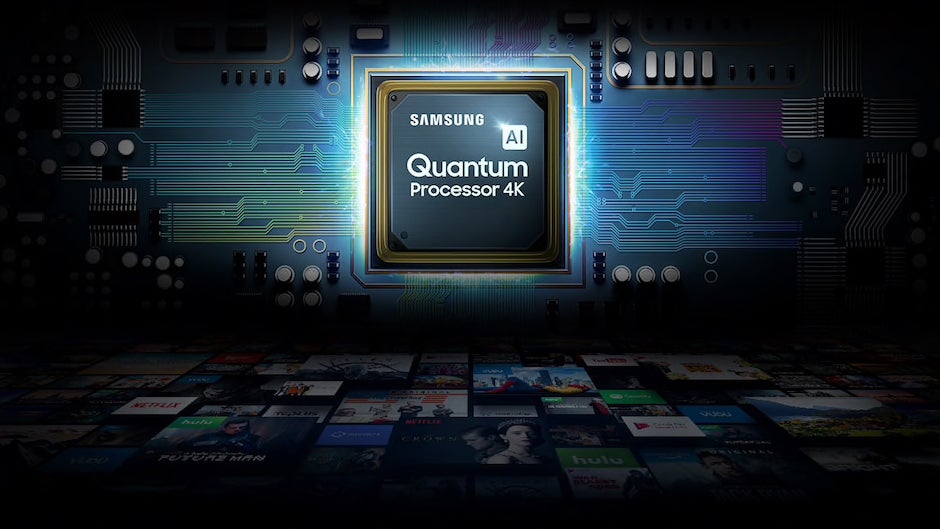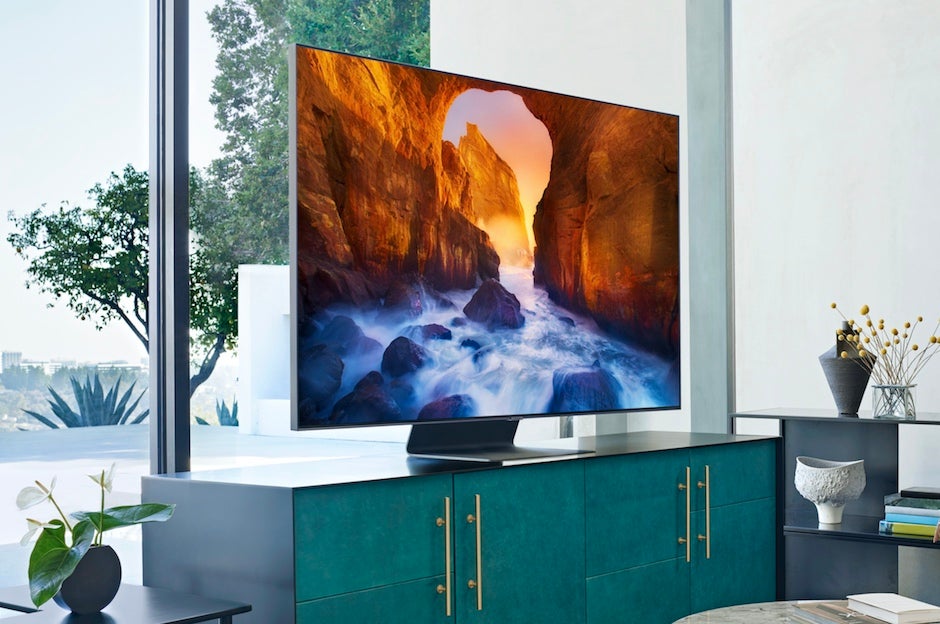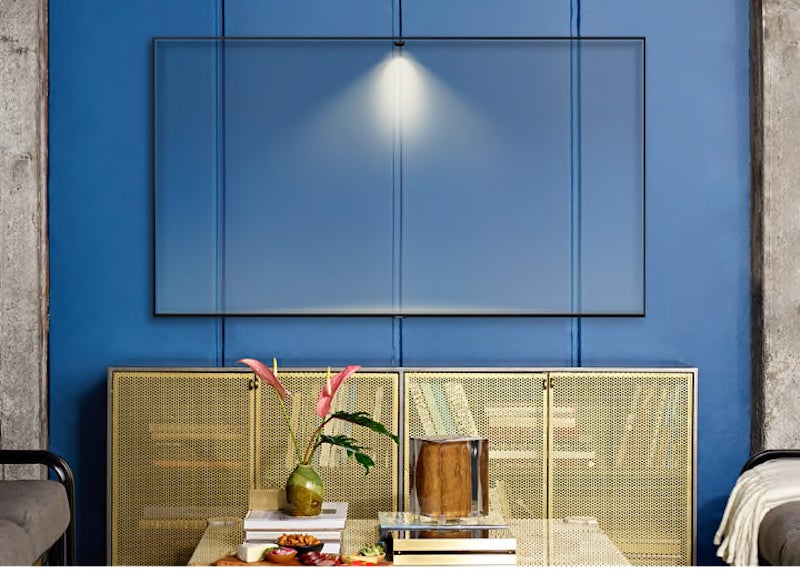Samsung QE55Q90R Review
Samsung QE55Q90R Review
The QE55Q90R is a genuine cutting-edge LCD TV
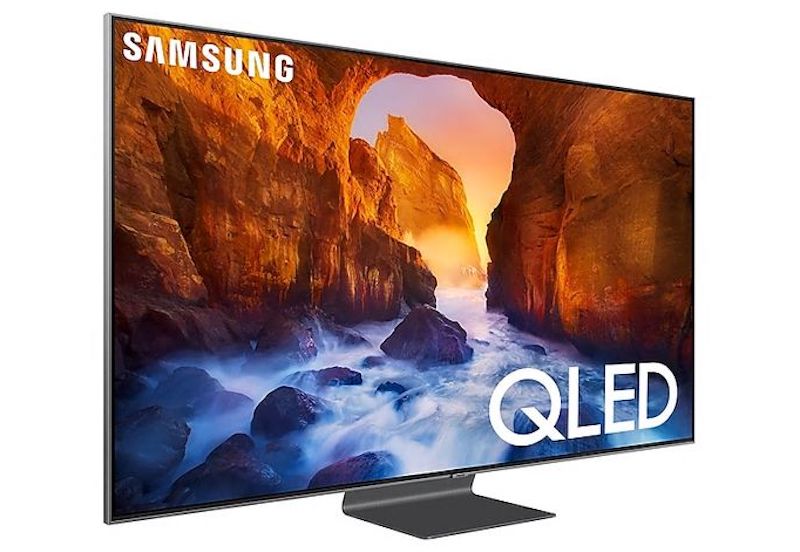
Verdict
The Samsung QE55Q90R looks like a genuine game-changer of an LCD TV. In particular, its black levels, backlight uniformity and viewing angles remain unique achievements in the LCD TV world. However, shadow detail reproduction is poor, so while the Samsung QE55Q90R is arguably the most all-round spectacular 55-inch TV around, the bigger QE65Q90R represents the performance sweet spot in the Q90R range if you’re able to afford it.
Pros
- Stunning black levels
- High peak brightness and rich colours
- Comprehensive smart TV system, including Apple TV app
Cons
- Crushed shadow details
- Some backlight bloom with off-angle viewing
- No Dolby Vision support
Key Specifications
- Review Price: £2299
- 55in LED TV with a native 4K resolution
- Full array local dimming system with 240 separate zones
- QLED colour technology
- Wide viewing angle technology
- Apple TV app support
What is the Samsung QE55Q90R?
The Samsung QE55Q90R (£2299) is the South Korean brand’s flagship 55in 4K TV for 2019. As such, it benefits from a direct LED lighting engine with hundreds of separately controllable local dimming zones; a claimed peak brightness of more than 2000 nits; and Samsung’s new wide-angle viewing technology.
Is all this enough to make it the best 55in TV in town?
Related: Samsung TV 2019 – every Samsung 4K QLED TV explained
Samsung QE55Q90R design and build quality – A sturdy and robustly built set
The Samsung QE55Q90R isn’t as slim as most of today’s TVs – a result of its use of a high-end direct backlighting system, where the LEDs sit behind the screen rather than around its edges. You don’t notice this from the front, though.
In fact, head-on the frame around its screen is impressively narrow, doing precious little to distract you from the pictures you’re watching.
The angled, centrally mounted stand is sturdy and nicely finished too – and, best of all, the set has only a single cable running into it, no matter the number of sources you have.
This is because the QE55Q90R ships with an external One Connect box into which all of your external sources run, supplying everything to the screen – including its power – via a single slender cable.
More innovation comes from Samsung’s Ambient mode. This is essentially a screensaver with knobs on, where the images you can play on-screen when you’re not watching it in earnest can be anything from famous digitised artworks to cool ambient colours, your own photographs, or even simple but cute animations.
The Ambient mode uses minimal power, allowing you to potentially use it all the time as an alternative to switching the TV into standby and creating a 55in black hole in your room.
You can even make the TV camouflaged if you take a digital photograph of the wall it’s positioned against and set that image to become the Ambient mode’s default display.
The QE55Q90R ships with two remote controls. One is your usual TV remote, replete with buttons and finished in a pretty lightweight plastic. The other is a much more attractive ‘smart’ remote that boasts a gleaming silver metal finish and a stripped-back button count.
This remote also carries a mic for enabling the TV’s voice-control features, and can be used to enable any equipment you have connected to the TV. Note, though, that while its lack of buttons might work quite well for day-to-day use of the TV, they can make its universal remote capabilities over-complicated.
Related: Best TVs
Samsung QE55Q90R features – Fewer dimming zones, but it does have a broad range of features
The Samsung QE55Q90R combines a full array local dimming (FALD) lighting engine with new video processing that includes a chipset entirely devoted to optimising its FALD performance. This is promising stuff given how excellent previous generations of Samsung LCD flagship TV have typically fared, even without a dedicated backlight control chip in place.
Counting the QE55Q90R’s separate dimming zones uncovers a surprise, however: there are only 240 of them, versus 480 on the 65in QE65Q90R. This means there are considerably fewer dimming zones per inch of screen in the 55in model – something that has consequences I’ll discuss in the Performance section.
The new Quantum Processor 4K chipset Samsung has developed for its 2019 high-end TVs delivers a number of picture and sound upgrades – including, most notably, 4K AI upscaling. This is a 4K version of the completely new approach to upscaling Samsung developed for its 8K TVs.
The QLED QE55Q90R also has a go at undermining one of the advantages of rival OLED technology, by supporting a new wide viewing angle technology that lets you watch the TV from almost right angles without black levels or colour saturations taking a customary hit.
Peak brightness is claimed by Samsung to be 2000 nits. I measured it in Standard picture mode at 1650 nits on a screen area of 10%, white HDR window – although this essentially halves after a few seconds.
The Movie preset holds on to its peak brightness levels pretty much indefinitely, but hits “only” 1436 nits on the same 10% window. The Dynamic mode peaks briefly at 1945 nits. But this isn’t a mode I’d recommend that you use.
The QLED technology I mentioned in passing earlier, meanwhile, uses metal-clad quantum dots to produce the Samsung QE55Q90R’s colour. And since these can be driven very brightly without suffering degradation, they can deliver extremely high colour volumes ideally suited to the wide colour gamuts that pretty much always accompany HDR content.
The Samsung QE55Q90R’s smart features come courtesy of the brand’s latest Eden system. This has gradually evolved over a number of generations into one of the TV world’s best smart interfaces. It now tidily handles a vast array of apps – including all the main video streaming and catch-up TV services – in a strikingly economical and easily customisable two-tier homescreen interface.
Related: What is HDR?
There have even been a couple of very significant Apple-flavoured additions to Samsung’s smart platform since we tested the QE65Q90R back in February. First, support for Apple AirPlay 2 enables easy file sharing from Apple devices. Second, and more significantly, the new Apple TV app.
Related: What is AirPlay 2?
Still exclusive to Samsung TVs at the time of writing – although coming to Vizio, Samsung, LG and Sony TVs later this year – the Apple TV app basically provides access to all of Apple’s iTunes library of TV shows and films. It will also support the Apple TV+ streaming service when it launches.
The only catch with the Samsung QE55Q90R’s smart features is the lack of support for Freeview Play. Nevertheless, the set does still separately carry all the terrestrial TV catch-up apps that Freeview Play pulls together.
Connections on the Samsung QE55Q90R’s One Connect box comprise four HDMIs, three USBs, and an optical digital audio jack. Plus, of course, it handles Wi-Fi and Bluetooth. In fact, Bluetooth is the only way to use headphones with this TV; Samsung ditched physical headphone jacks on its high-end TVs a couple of generations ago.
The HDMIs don’t claim full HDMI 2.1 specification such as those on LG’s high-end 4K TVs this year. However, they do support two key gaming-related features associated with the 2.1 specification: Auto Low Latency Mode (ALLM) and VRR (Variable Refresh Rate).
The first of these sees the TV automatically switch into its fast response Game mode (where it takes less than 15ms to render images) on detection of a game source. The second sees the TV able to adapt its frame rate on-the-fly to match that of the game you’re playing. This stops the notorious screen “tearing” effect with which console gamers have become all too familiar.
Related: What is HDMI 2.1?
The Samsung QE55Q90R doesn’t support eARC over any of its HDMIs. As such, it can’t pass through the lossless versions of Dolby Atmos and DTS:X found on many 4K Blu-rays.
One other thing the Samsung QE55Q90R can’t do is Dolby Vision. Samsung continues to refuse to support Dolby’s premium HDR format, with its extra scene-by-scene picture information and 12-bit colour mastering.
It does support the Samsung-developed rival to Dolby Vision that is HDR10+, however. This also provides extra scene-by-scene picture data that isn’t provided in a standard HDR10 video feed.
At the time of writing far more content is available in Dolby Vision than HDR10+ – although HDR10+ is growing, and notably has the support of all the HDR shows on Amazon Prime Video.
Related: What is HDR10+?
Samsung QE55Q90R setup – Movie and Standard mode are the best starting points
Before you do anything else, I recommend going into the Samsung QE55Q90R’s General menu and turning off the Eco mode. Otherwise, the picture will become particularly dull whenever you dim the lights and close the curtains for serious movie viewing action.
Of the Samsung QE55Q90R’s four picture settings, the Movie and Standard settings will for most people be the ideal starting point to getting the best out of their new TV.
Personally, I tend to use Standard the most, since it delivers a dynamic, bold image that makes the best all-round use of the TV’s extensive talents. But the backlight will benefit from being nudged down slightly, and the Colour Space is best switched from Native to Auto.
The biggest issue with the Standard mode is that, at its default settings, it can cause details in dark areas to be crushed out of the picture. As a result, you may feel you need to nudge up brightness one or two notches. Resist the temptation to go too far here, though: upping the brightness also shifts the picture’s colour tone.
Either deactivate the set’s Auto Motion settings completely, or choose the Custom option and set judder and blur reduction to three or four.
It’s worth familiarising yourself with the Digital Clean View feature, too. I’d suggest leaving it off when you’re watching high-quality sources, but calling it in when you’re watching a very low-quality HD or, especially, SD source.
The Movie mode delivers a duller, more desaturated image than Standard. Nevertheless, it’s nicely balanced and brings out much more shadow detail in its default state. In addition, it’s designed to more closely track the original mastering values of the SDR or HDR content you’re watching.
Personally, I find the Movie mode slightly yellow in its default settings, but you can reduce this via the TV’s provided adjustments. Otherwise, it offers a decent improvement over previous Samsung Movie modes.
Samsung QE55Q90R performance – Exceptional black levels
Having already done an in-depth analysis of the Q90R range’s picture performance in this review of the Samsung QE65Q90R, I’ll keep things here as simple as I can.
The first thing that struck me about this screen were its exceptional black levels. I’ve seen a number of 2019 OLED TVs since testing the QE65Q90R, yet the Samsung QE55Q90R’s black levels still look remarkably impressive – easily the best of any LCD TV to date, and a genuine challenge to those you get with OLED TVs.
They’re remarkably deep and uniform, too, even when there’s a bright object at the centre of a dark backdrop – such as the white Sony logo that appears on a black background at the start of Sony 4K Blu-rays.
The lack of significant blooming (backlight clouding) around this white logo is remarkable for an LCD TV, and speaks volumes to the quality of Samsung’s new local dimming chipset. It’s all the more striking on the QE55Q90R because this lack of blooming is being delivered by only half as many dimming zones as it was on the previously tested QE65Q90R.
But the Samsung QE55Q90R’s killer app is that whilst delivering fantastically deep black levels at one end of the video spectrum, it’s also able to present HDR sequences with a level of brightness – both across the whole screen, and in relatively small areas of peak brightness – that make HDR’s expanded brightness range shine.
Colours are beautifully saturated, too. This is especially impressive during very bright scenes, where the TV’s QLED technology enables the QE55Q90R to track colour volumes much further into HDR and wide colour technology’s most extreme areas than OLED TVs. The latter struggle to get above 800 nits of peak brightness.
Put all this brightness and colour intensity side by side with the Samsung QE55Q90R’s class-leading black levels, and you’ve got arguably the most flat-out spectacular HDR pictures in the TV world.
Note that the way Samsung’s wide viewing angle technology works slightly compromises resolution, but the QE55Q90R’s pictures still look beautifully crisp and clean. And the viewing angle pay-off seems worth the marginal resolution reduction, resulting in you being able to watch the QE55Q90R from almost any angle without loss of contrast or colour.
Motion is handled well if you follow the setup advice suggested earlier, and the set’s upscaling of sub-4K sources is startling – especially when it comes to making really low-quality sources, such as heavily compressed web video, easier to watch.
Also impressive is the way a Moth Eye filter on the Samsung QE65Q90R’s screen resists reflections much better than the majority of its (especially OLED) rivals.
Having mentioned OLED again, though, there are a trio of areas where the Samsung QE55Q90R’s clever new backlight control system can’t entirely escape its LED origins.
First, unless you use the Movie preset – which applies a less aggressive local dimming system and so delivers slightly reduced black levels and generally more muted images – the local dimming can cause some small details to disappear from the picture.
Related: OLED vs QLED – Television technology’s battle royale
A great example of this is the word “Replicant” at the start of Blade Runner 2049 on 4K Blu-ray. This word appears small and red, and ahead of the white explanation text that follows.
In every QE55Q90R preset mode bar Movie, you can’t see the word at all until the white text also kicks in. And no setting I tried – be it backlight, contrast, local dimming power or brightness – made any difference to this.
Given that the “Replicant” word is by no means faint (it’s just quite small, and appears against a black backdrop), it’s easy to see why very dark scenes outside of Movie mode sometimes look like they’re missing shadow detail.
The second, related issue is that even when they don’t completely disappear into the darkness, small, stand-out bright areas can appear noticeably dimmed down on occasion, as the QE55Q90R works to avoid the dreaded backlight “bloom” effect so common to LCD TVs.
You can see this most easily with end credits that appear against a black backdrop, as differences in the intensity of the text appear over different parts of the screen, depending on how much text there is in each particular dimming zone.
The third backlight issue is shifting black levels when the TV has to display HDR images containing an extreme mix of light and dark content. It seems as if Samsung’s desire to avoid backlight clouding with such extreme and complex content is leading the QE55Q90R to reduce the potency of its local dimming system, so that brightness levels shift across the whole screen rather than just parts of it.
Actually, this is probably less distracting than heavy local backlight clouding. But that’s not to say that it isn’t itself capable of sometimes distracting you from what you’re watching. The issue appears stronger on the 55in model than the 65in set, presumably as a result of the smaller model’s reduced dimming zone count.
In fact, all of the Samsung QE55Q90R’s backlight issues seem slightly more pronounced than they are on its 65-inch sibling.
If you can feed the set HDR10+ sources pictures enjoy both a little more dynamism and refinement. Of course, we’re unable to see if the same applies to Dolby Vision sources, since the QE55Q90R doesn’t support that format.
One last thing to be aware of is that while the QE55Q90R’s wide viewing angle technology works remarkably well in most ways, people watching side on will notice blooming around stand-out bright objects, which isn’t apparent to those watching head-on.
Joining the Samsung QE55Q90R’s frequently spectacular pictures is a satisfyingly potent audio system. Despite not carrying any forward-firing speakers, the QE55Q90R manages to cast its sound across a wide but coherent and highly detailed sound stage.
Voices sound clean and well located on the screen, despite lacking forward projection. Plus, there’s enough power to allow the sound to shift up and down through at least a couple of gears to cope with the audio ebb and flow of action movies.
The only catch with the QE55Q90R’s sound is that moments of really extreme bass can go beyond the TV’s low-end capabilities, causing some noticeable distortions and crackles.
Should I buy a Samsung QE55Q90R?
The Samsung QE55Q90R gets closer than any other 55-inch TV to date to combining the strengths of LCD TVs with the strengths of OLED TVs. The result is unprecedented black levels and viewing angles for an LCD screen, alongside more traditional LCD strengths of high brightness and large colour volumes.
There’s an impressive roster of smart features, too, including the recently added Apple TV app.
While brilliant most of the time, though, Samsung’s new local dimming engine can be a bit too enthusiastic at times. This costs the image some small, low-brightness detail when using the otherwise most satisfying picture settings. The 65in model, with more than twice as many controllable dimming zones, is a superior performer in this respect.
The only other LCD TV range that gets close to the pictures of the QE55Q90R is Samsung’s own Q85R range. This drastically reduces the number of local dimming zones again, so you can see slightly more backlight blooming. Nevertheless, it delivers mostly excellent black levels and, in a reversal of the situation with the Q90R range, the £1800 QE55Q85R actually has a slightly greater number of dimming zones than the larger 65in QE65Q85R. This results in punchier, more dynamic images.
Otherwise, the main competition for the Samsung QE55Q90R comes from the LG C9 and Panasonic GZ1000/GZ1500 OLED TVs. Thanks to OLED’s ability to have each pixel produce its own light, both those sets excel over the Samsung at producing very small areas of brightness without any accompanying blooming or loss of intensity. They also produce more shadow detail in dark scenes, and there’s no blooming during off-axis viewing. But they can’t deliver nearly as much light output with bright HDR scenes as the Samsung QE55Q90R.
How we test televisions
We test every TV we review thoroughly over an extended period of time. We use industry standard tests to compare features properly. We’ll always tell you what we find. We never, ever, accept money to review a product.

